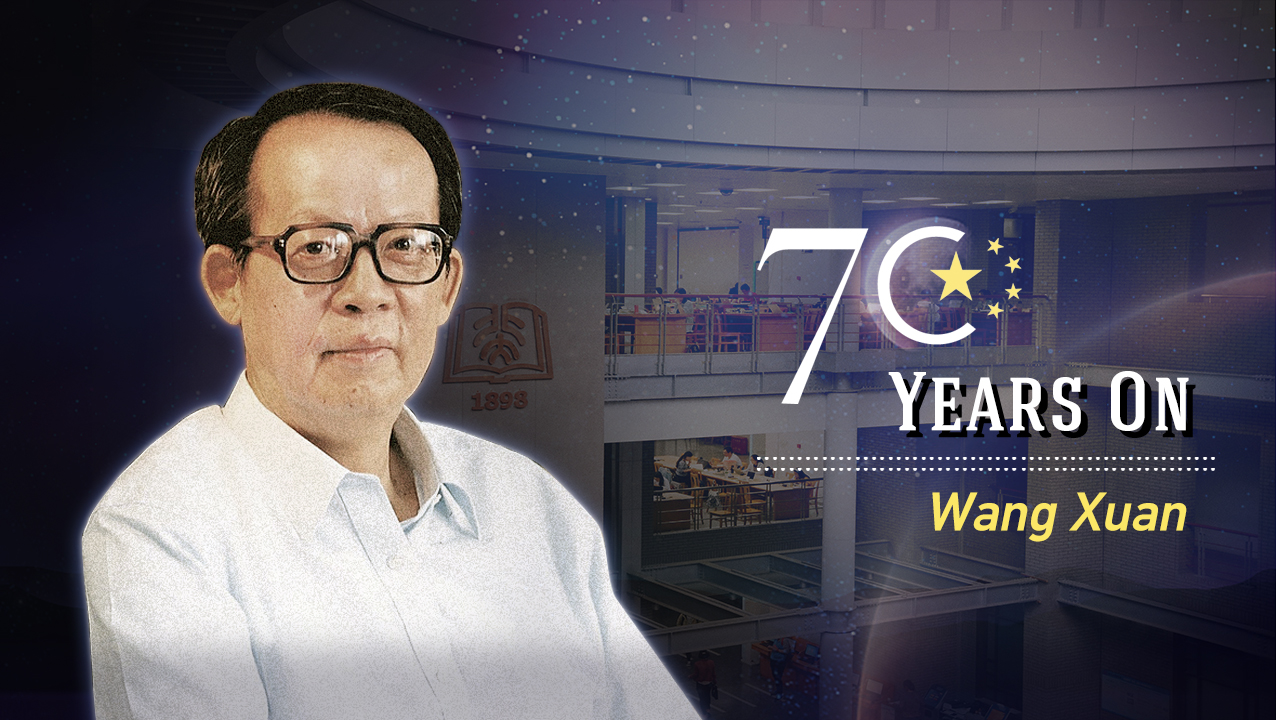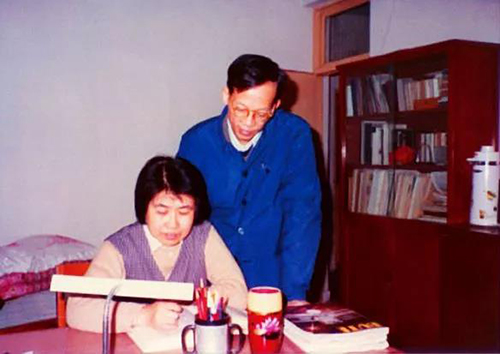[70 years on] Wang Xuan: Exploring the way of independent innovation
Sep 27, 2019
Editor’s Note: This story is part of a series of articles celebrating the 70th anniversary of the founding of the People’s Republic of China. Each article shines the spotlight on one PKUer who has made remarkable contributions to China’s recent development, highlighting not only the importance of their individual accomplishments, but also the significant impact Peking University has had on China’s development over the past 70 years.
Peking University, Sept. 27, 2019: It was a warm winter morning in Beijing on February 1, 2002. Dressed in a dark blue suit, Wang Xuan came to the Great Hall of the People in Beijing. That day, he stood on the podium of the Highest Science and Technology Award.
In 2018, a grand gathering was held to celebrate the 40th anniversary of the reform and opening up. The CPC Central Committee and the State Council awarded 100 individuals the honorary title of “reform pioneer” for their outstanding contributions. Wang is one of them.
The title represents the highest tribute of the nation to Wang’s development of laser typesetting system for Chinese characters and Founder color publishing system, a technological revolution in China’s publishing and printing industry.
 Wang Xuan
Wang Xuan
Growth and decisions
Wang was born in 1937. At the age of 17, he was admitted to Peking University. Since then he had studied and worked for 52 years by the side of the Weiming Lake.
At the end of the sophomore year, students began to choose their majors. At that time, mathematics was popular while computational mathematics was a newly founded subject. However, with keen insight and foresight, Wang resolutely chose the novel subject. After graduation, he stayed at PKU to teach and presided over the electronic tube computer logic design and debugging work.
Choosing major was not the only choice Wang made which had influenced his life greatly. The second big decision, “the most important decision of my life” as he said, was made when Wang was reading English version for the latest development of computer technology. He asked himself: “Why only admire the achievements of others? Why not put our own innovative ideas into practice?” He tried to find the source of creation, that is, the background of these innovative ideas, and gradually realized that the application and program were very important for hardware design. If he only mastered the hardware design, but did not understand the program and application, he still could not come up with innovative ideas. Therefore, Wang decided to shift his focus from hardware to software without giving up on hardware. He engaged himself in studying the combination of hardware and software to explore the impact of software on future computer architecture.
Wang believed that cross-disciplinary research is an important factor in reaching innovative results. As the cybernetics inventor Wiener said: Work in the blank space between established disciplines, and the most fruitful results can be achieved.
“Scientists’ initial motivation is to explore unknown areas.”
In addition to his busy research, Wang managed to squeeze out time every night to read about the latest progress of computer technology. More than 40 years ago, our country's computers were mainly used in scientific operations and advanced national defense projects. There were no precise Chinese characters in the system. Newspapers, books and periodicals were mainly typed and printed in movable type with low efficiency. To this end, in August 1974, New China set up the national key scientific and technological research project "748 Project" to develop a Chinese character processing system. The most difficult step was to compress precise Chinese characters into the computer. Wang foresaw that the system would be an important part of the project with immeasurable value. He decided to work on it.
“Applied research must start at a high level, focusing on the future trend of technology; otherwise, our research will be lagging behind the rapidly progressing society, forcibly following the footsteps of foreign technologies.” Wang believed. Therefore, after extensive reading, he moved beyond the second and third generation to work on the fourth generation of laser typesetting.
"Wang Xuan always designs. Many of his plans come out on business trips, on airplanes and even on buses," Wang’s wife, Chen Kunqiu said. “He's really busy with his research. I would let him help me with housework and we would chat at meals, so that he can catch his breath. But he seldom talks. Sometimes in the middle of housework or dinner, he would run into his study and write down something. I know he's always thinking about problems.”
Chen was a senior student in Wang’s department. After graduation, they both stayed in the math department to teach. They fell in love with each other and spent a difficult time hand in hand. In 1975, Chen undertook all the design and implementation of the large-scale software of the domestic computer Chinese character laser typesetting system (Huaguang system and Founder system). Wang wrote in his will: "I am most fortunate to be combined with Chen. Without her, there would be no laser phototypesetting."
In 1975, Wang chose the unique method of "parametric representation of regular strokes and outline representation of irregular strokes" to compress thousands of gigabytes of Chinese character font information and store it in a computer with only a few megabytes of memory. This was the first time in the world that new China has stored precise Chinese characters in a computer. After four years of continuous research, Wang's team successfully output Chinese characters from the computer using the advanced laser Phototypesetting Technology at that time. This achievement left western countries far behind and made Wang the first scientist in Chinese mainland to receive a European patent.
 Wang and his wife
Wang and his wife
At the time, Wang’s plan had long been suspected of being overly ambitious. With the reform and opening up, universities and researchers began to learn from abroad. Besides, foreign photo typesetters were also coveting the Chinese printing and publishing market. Facing internal and external challenges, Wang continued the research with his team because of his confidence in his own design method, his belief in the broad market prospects and his ambition of winning glory for China with technological breakthrough. Their team decided to step up the development of the prototype of principle, and at the same time they started to develop a truly practical type II machine based on large-scale integrated circuits.
With the hard work of Wang’s team, on September 15, 1980, a 26-page sample book The Sword of Wuhao (“Wu Hao Zhi Jian”) was finally printed, marking the end of the era of “lead and fire” and the beginning of a new era of “light and electricity”.
In three years, Wang and his laser typesetting system created a miracle in the domestic and overseas markets: his invention accounted for 99% of the domestic and 80% of the overseas Chinese newspaper industry. In 1986, the Economic Daily became the first newspaper in China to test Huaguang III, a new typesetting system invented by Wang’s team. In 1988, the Economic Daily got rid of all the lead characters and became the first printing house in China to completely abolish using lead Chinese characters. In 1989, Huaguang IV began to gain popularity in domestic press, publishing and printing industries. At the end of this year, all foreign companies that came to China to develop and sell photo typesetting systems withdrew from the mainland market.
In 1995, Wang led the establishment of the Founder Technology Research Institute, composed of a complete chain of research, development, production, sales, training and after-sales service. Nowadays, Founder group has developed from an enterprise that survived only by Laser Phototypesetting Technology to a group company with dozens of projects and the largest university-run enterprise in China.
“By reviewing Wang’s path of scientific and technological innovation and experiencing his scientific spirit, we can understand the real meaning of independent innovation. Follow his model, and the horizon of independent innovation will be broader.” Han Qide, Academician of the Chinese Academy of Sciences, said.
 Wang Xuan
Wang Xuan
Having students all over the world
Wang is a famous scientist, not only because of his achievements in scientific research, but also because of his broad vision and mind. He measured his contribution by the number of young talents he had cultivated. He understood the rule of talent growth. "Many first-class scholars in the history of computer science achieve their first outstanding achievements before the age of 40."
Wang said: "It's the happiest thing to witness young people's brilliance. It's also the most painful thing to watch them waste their talent in the wrong direction or by poor management.”
As a master’s and doctoral supervisor of computer application specialty, Wang believed that the most important thing was to encourage students to choose challenging research topics with promising future application, and then make every effort to provide them with what they need for success.
Based on this idea, Wang guided students to develop the world's first Windows-based Chinese professional typesetting software, the first large-screen newspaper editing system and color publishing system and other pioneering projects. He often encouraged young people: "You are leading the new trend of technology; you are making history!"
In 2008, two years after Wang passed away, his wife Chen donated 10 million yuan to PKU to establish Wang Xuan Foundation for youth scholars.
Liu Yandong, former vice premier and head of the United Front Department of the Central Committee, said: “Wang devoted his life to exploring a way of independent innovation in China and established a monument of independent innovation. It is the most precious wealth for future generations.”
Written by: Wei Qijia
Edited by: Yan Shengnan
Source: PKU News (Chinese)
Photo credit to: Wangxuan Institute of Computer Technology


